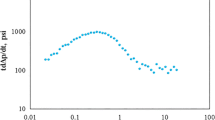Abstract
This article introduces a new optimisation algorithm designed for sampling the solution space of non-linear, non-convex quadratic problems. This method has been specifically designed for inversion problems where multiple distinct scenarios must be explored, which would not be achievable with a standard ensemble-based optimisation method (EnOpt). A prior ensemble is used to sample the uncertainty of the parameters before updating each member of the ensemble independently in order to find the minimum of an objective function. This update is given by a Gauss–Newton-like approach, where the first-derivative matrix is adaptively estimated from sub-ensembles of parameters and their corresponding forward model responses. As the first-derivative matrix is statistically computed from an ensemble of realisations, the forward model does not need to be known and the algorithm is independent of it. The final ensemble provides an estimation of the uncertainty after the inversion process. The efficiency of this adaptive ensemble optimisation (A-EnOpt) method is first tested on simple two-dimensional problems where known mathematical functions are used as forward models. The results show that the method minimises the objective functions and samples the final uncertainties of the problems to a better degree than a standard EnOpt. The A-EnOpt method is then applied to a real heavy-oil field petrophysical inversion. Porosity, shale fraction and fluid saturations are inverted under continuity and Lagrange constraints, conditioned by P-impedance models from stochastic seismic inversion. The updated properties are incorporated in a fluid flow model of the field. The simulation results produce a better match to historical production data at one well than equivalent flow simulations using the properties before inversion. This shows that conditioning by seismic data improves the quality of the geological models.








Similar content being viewed by others
References
Boyd SP, Vandenberghe L (2004) Convex optimization. Cambridge University Press, Cambridge
Buland A, Omre H (2003) Bayesian linearized AVO inversion. Geophysics 68(1):185–198
Chen Y, Oliver DS (2012) Ensemble randomized maximum likelihood method as an iterative ensemble smoother. Math Geosci 44(1):1–26
Chen Y, Oliver DS (2013) Levenberg–Marquardt forms of the iterative ensemble smoother for efficient history matching and uncertainty quantification. Comput Geosci 17(4):689–703
Conrad PR, Marzouk YM, Pillai NS, Smith A (2016) Accelerating asymptotically exact MCMC for computationally intensive models via local approximations. J Am Stat Assoc 111(516):1591–1607
Dehdari V, Oliver DS et al (2012) Sequential quadratic programming for solving constrained production optimization-case study from Brugge field. SPE J 17(03):874–884
Doyen P (2007) Seismic reservoir characterization: an earth modelling perspective, vol 2. EAGE Publications, Houten
Dvorkin J, Gutierrez MA, Grana D (2014) Seismic reflections of rock properties. Cambridge University Press, Cambridge
Emerick AA (2016) Analysis of the performance of ensemble-based assimilation of production and seismic data. J Petrol Sci Eng 139:219–239
Emerick AA, Reynolds AC (2013) Ensemble smoother with multiple data assimilation. Comput Geosci 55:3–15
Evensen G (2003) The ensemble Kalman filter: theoretical formulation and practical implementation. Ocean Dyn 53(4):343–367
Fröberg CE (1969) Introduction to numerical analysis. Addison-Wesley Publishing Company, Reading, MA
Gentilhomme T, Oliver DS, Mannseth T, Caumon G, Moyen R, Doyen P (2015) Ensemble-based multi-scale history-matching using second-generation wavelet transform. Comput Geosci 19(5):999–1025
Gineste M, Eidsvik J (2015) Framework for seismic inversion of full waveform data using sequential filtering. In: Petroleum geostatistics 2015, European Association of Geoscientists & Engineers, cp-456
Gineste M, Eidsvik J, Zheng Y (2020) Ensemble-based seismic inversion for a stratified medium. Geophysics 85(1):R29–R39
Golub GH, Van Loan CF (1989) Matrix computations, 2nd edn. Johns Hopkins University Press, Baltimore
Gu Y, Oliver DS (2007) An iterative ensemble Kalman filter for multiphase fluid flow data assimilation. SPE J 12(4):438–446
Hastings WK (1970) Monte Carlo sampling methods using Markov chains and their applications. Biometrika 57(1):97–109
Liberti L, Maculan N (2006) Global optimization: volume 84, from theory to implementation. Springer, Berlin
Liu M, Grana D (2018) Stochastic nonlinear inversion of seismic data for the estimation of petroelastic properties using the ensemble smoother and data reparameterization. Geophysics 83(3):M25–M39
Lorenzatto R, Juiniti R, Gomes J, Martins J (2004) The Marlim field development: strategies and challenges. In: Offshore technology conference, offshore technology conference
Mavko G, Mukerji T, Dvorkin J (2009) The rock physics handbook. Cambridge University Press, Cambridge
Moyen R, Doyen P M (2009) Reservoir connectivity uncertainty from stochastic seismic inversion. In: SEG technical program expanded abstracts 2009, Society of Exploration Geophysicists, pp 2378–2382
Oliveira RM et al (2008) The Marlim field: incorporating 4D seismic in reservoir-management decisions. J Petrol Technol 60(04):52–110
Oliver DS, Reynolds AC, Liu N (2008) Inverse theory for petroleum reservoir characterization and history matching. Cambridge University Press, Cambridge
Powell MJ (1994) A direct search optimization method that models the objective and constraint functions by linear interpolation. Springer, Berlin
Pyrcz MJ, Deutsch CV (2014) Geostatistical reservoir modeling. Oxford University Press, Oxford
Tarantola A (2005) Inverse problem theory and methods for model parameter estimation. SIAM, Philadelphia
Thurin J, Brossier R, Métivier L (2019) Ensemble-based uncertainty estimation in full waveform inversion. Geophys J Int 219(3):1613–1635
Ullmann De Brito D, Moraes R, Emerick AA (2010) The Marlim field: Incorporating time-lapse seismic in the assisted history matching. In: SPE Latin American and Caribbean petroleum engineering conference, society of petroleum engineers
Zhigljavsky A, Žilinskas A (2007) Stochastic global optimization, vol 9. Springer, Berlin
Acknowledgements
The authors would like to thank Petrobras for supporting this work and granting permission to show the data.
Author information
Authors and Affiliations
Corresponding author
Rights and permissions
About this article
Cite this article
Moyen, R., Gentilhomme, T. Adaptive Ensemble-Based Optimisation for Petrophysical Inversion. Math Geosci 53, 349–373 (2021). https://doi.org/10.1007/s11004-020-09900-2
Received:
Accepted:
Published:
Issue Date:
DOI: https://doi.org/10.1007/s11004-020-09900-2




